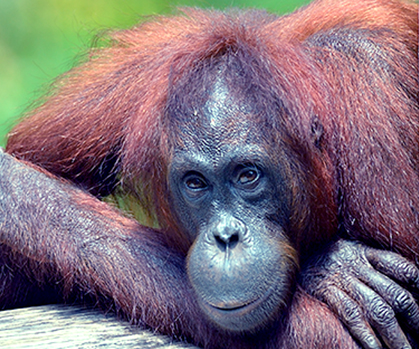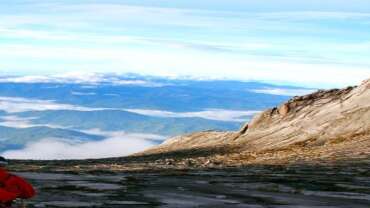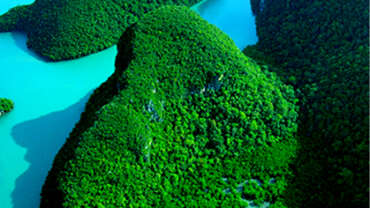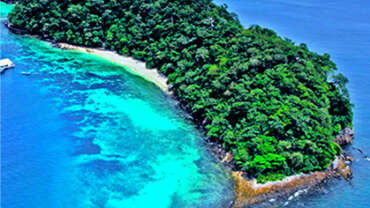Tropical Wilderness Paradise
KL BIRD PARK
KL Bird Park exhibits thousands of colourful birds from various species and sizes, housed within lush trees that resemble Malaysia’s pride in rainforests.
Set in the heart of the busy, always bustling Kuala Lumpur, the park sprawled across 20.9 acres of land and houses an extraordinary collection of 3000 birds of approximately 200 different species, from both local and foreign origin.
A renowned eco-tourism destination, the park boasts the main feature of free-flight concept – reputed to be the largest free-flight walk-in aviary in the world; giving each visitor a rare chance to embrace and to be surrounded by free-flying birds roaming throughout the park. KL Bird Park is made up of 4 zones, with Zone 1 & Zone 2 houses the free-flight aviary sections, Zone 3 houses hornbills, and Zone 4 accommodates birds in separate cages and aviaries.
The free-flight concept was proven to be beneficial, as KL Bird Park has produced an exceptional breeding rate as a result of the swift adaptation from the birds to the settings. The environment of lush trees facilitates numerous nesting sites for its inhabitants; making the park a conducive breeding site for the birds.
KL Bird Park operates daily even on weekends, public holidays, and school holidays; making it a perfect family destination. This perfect mini escape from city life is easily accessible and also boasts several kiosks and cafes. The Hornbill Restaurant & Cafe stands out more than the others; an eatery within the hornbill zone of the KL Bird Park which possesses a distinctive design of architecture inspired by the Malay Kampung House. Dining at the protruded verandah of the restaurant might give you a chance to enjoy a surprise visit from the majestic Rhinoceros Hornbill.
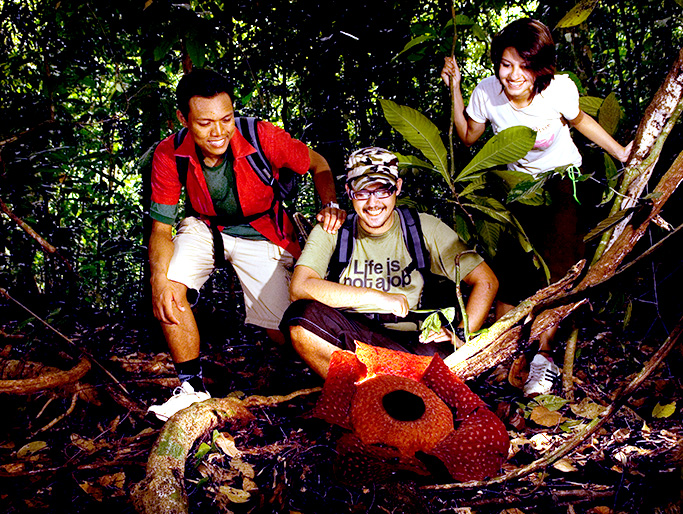
TAMAN NEGARA
Malaysia’s National Treasure
Pack your backpack and prepare for a journey to remember as you venture through the flora and fauna of Malaysia’s beating heart.
Being amongst the oldest rainforests in the world – 130 million years old – covering up to 4,343 square kilometres of Malaysia and located in Pahang. Welcome to Taman Negara!
Taman Negara has flourished its name throughout the globe ever since it was established in 1938. This humongous park hosts up to 150 mammal species from the harmless Sambar Deer to the fearless Malayan Tiger; as well as 479 species of birds have been spotted to inhabit the area including Hornbills, Fireback Pheasants, Fishing Eagles, Kingfishers, Masked Finfoots, Broadbills, Drongos, and Blue-throated Bee-eaters, just to name a few.
Filled with magnificent wonders throughout, it exhibits a wide range of places to explore. From refreshing waterfalls, rushing rapids and tortuous rivers to 40-metre canopies, plush valleys and a majestic mountain range with the vivid landscape of Mount Tahan. What a view to experience before even scaling the 2,187m mountain itself. These are among the awesome activities available in Taman Negara.
Your visit to the jungle is never complete without trekking far into its depths. With plentiful wildlife to feast your eyes upon, Taman Negara will never cease to amaze you with its treasures; from the sightings of the stunning pitcher plant to spotting the elusive black panther amidst the bushy branches. Next, trekking in the day will leave you flattered by the beautiful flora and fauna including the great gargantuan banyan roots – accompanying you along your journey. At night, you may potentially set your eyes upon wild boars, monkeys, as well as the Malayan deer.
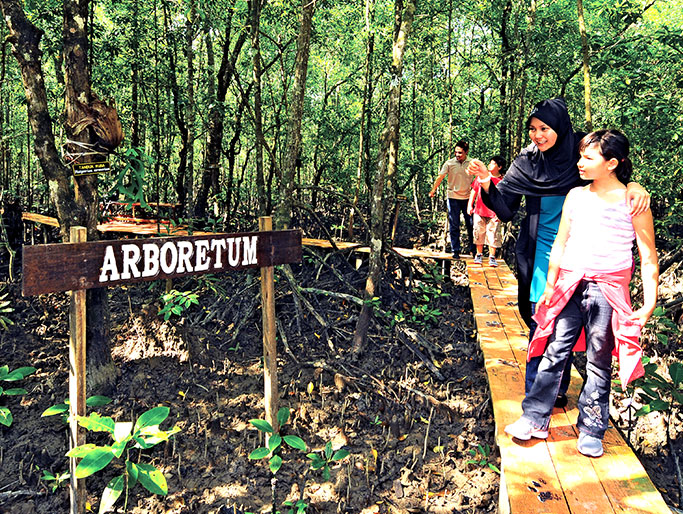
PULAU KUKUP NATIONAL PARK
A Wonderful Natural Ecosystem of Pulau Kukup National Park
Located in the Southern district of Peninsular Malaysia, Pulau Kukup will leave visitors in awe of its magnificent mangrove ecosystem.
The National Park of Pulau Kukup was established in 1997, as a diligent effort to conserve and protect one of the largest mangrove islands in the world.
Possessing unique ecological characteristics, the uninhabited island tucked in the district of Pontian, Johor also received international recognition by RAMSAR – as a Wetland of International Importance. The island is deemed as a vital refuge for mangrove-associated flora and fauna including some of the rare and threatened species. This dazzling labyrinth of the mangrove island will be a spectacular sight for all visitors as they discover the secret life within this unique ecosystem – aided with the presence of the park’s signage, viewing platforms, and boardwalks.
FLORA
In this perfect island of mangrove preservation, at least 18 true mangrove species are able to grow to their full potential; undisturbed by the interference of human and modern development. The island is adorned by a wide range of mangrove species, including the tallest in the country: Sonneratia Alba.
FAUNA
The park is also home to beautiful magnificent creatures, with some of them (such as the flat-headed cat) are listed in the IUCN Red List as well as the Bearded Pig, an endemic creature in Johor. Flying Foxes, Smooth Otters, Asian Palm Civet, Mangrove Skinks, Saltwater Crocodile, and Dog-faced Water Snake are amongst the frequent creatures that can also be seen roaming in Pulau Kukup. The park is also an important Bird & Biodiversity Area in Malaysia, being identified as a place with a prevalent significant for the conversation of various rare and globally threatened bird species such as Milky Stork, Chinese Egret, and Lesser Adjutant.
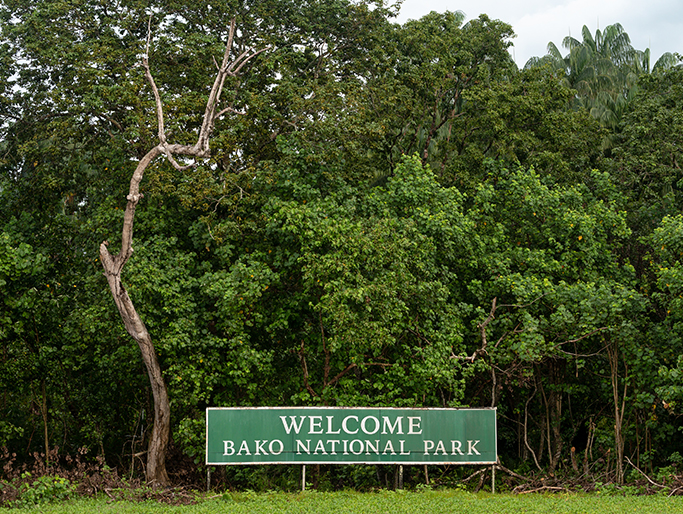
BAKO NATIONAL PARK
The Tropical Wonders of Bako National Park
Bako National Park is the oldest and one of the most frequented attractions in Sarawak, depicting the unrivaled biodiversity of the magnificent Borneo Rainforest.
The park is located about 47 km away from Kuching on the Muara Tebas peninsula, making the national park a strategic spot for local visitors and foreign tourists. Bako was officially made a national park in 1957 and spans for only 27 square kilometers; it is one of the smallest national parks in Malaysia.
Albeit being small in size, the park offers diverse landscapes and multiple ecosystems that highlight different parts of the park. Such diversity includes steep coastline cliffs, tropical beaches, mangroves, and coves. Aside from that, the park also features streams, rivers, swamps, beaches, a dipterocarp forest, and diverse vegetation.
DIVERSE FLORA AND FAUNA
Housing diverse flora and fauna species, the park is truly a paradise for nature lovers. There are approximately 600 flower species available in the park which includes the rare carnivorous pitcher plants and elegant orchids. Well known for its extensive list of available vegetation, the park also exhibits decoration of flowers; flourishing the park in a lush harmonious colour that further enriches its scenery.
Bako National Park is also home to 267 wildlife species which casually roam the park’s compound such as silver leaf monkeys, long-tailed macaques, slow loris, flying lemurs, mouse deer, wild boars, civets, pangolins, and the pinnacle of the park; the rare wild proboscis monkeys.
PRISTINE BEACHES AND BLUE SEA
Bako National Park also takes pride in its white sandy beaches, providing a relaxing shift for a short rest throughout your journey in the jungle. Telok Pandan Kecil trail will lead you to one of the park’s most remarkable beaches – Telok Pandan Kecil beach which boasts glorious rocky headlands, offering an astonishing view mimicking a secluded bay.
Million years of erosion have sculpted the rocky headlands into splendidly shaped sea stacks and sea arches. This includes the ever-iconic Bako sea stack which is considered as one of the country’s geological treasures. Most of the park’s beaches feature a steep sandstone and limestone cliffs, rocky golden brown headlands, white sands, and unique rock formations that are scattered across the beaches.
Bako National Park offers an unparalleled experience of the opulent Sarawak rainforest. If you’re looking for a place to get in touch with nature or to explore the wonders of Borneo’s finest treasure, start planning your trip to Bako National Park now.
ADVENTURE IN THE JUNGLE TRAILS
The park implores visitors to venture deep into a wholesome nature experience through its 18 walking trails, colour-coded according to their length. You are welcomed to choose a trail that fits your preferences and indulge yourself in different pre-planned activities with your family and friends. 11 trails of Bako National Park will end within the park, while 7 others will bring your exploration to an end at the beach.
For visitors that are looking for a more adventurous experience rather than a casual walk through the jungle, you can opt for a full-day jungle hike or an overnight camping journey; an imperious chance to graze the wildlife up close and to enjoy the light breeze of nature alongside a series of streams and captivating waterfalls.
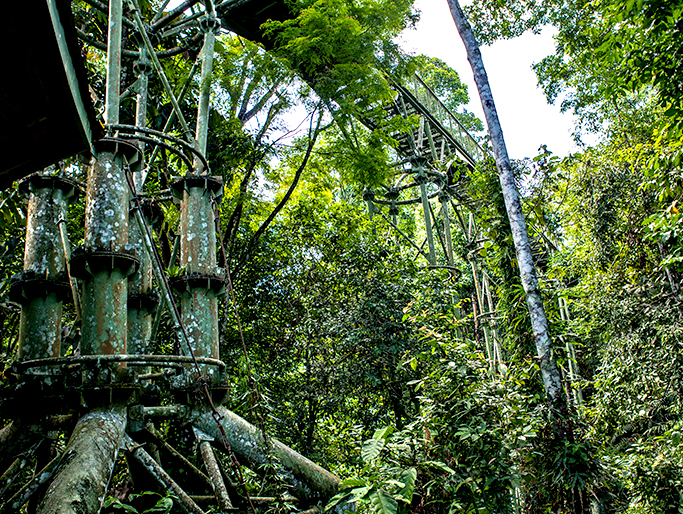
RAINFOREST DISCOVERY CENTRE
Explore the Marvellous Rainforest Discovery Centre
A gateway to lush green scenery, Sabah Rainforest Discovery Centre will bring an appealing experience to all visitors away from the hustle and bustle of the city.
Regarded as one of the best environmental education facilities in Sabah, the Rainforest Discovery Centre is one of the most accessible rainforests in Sabah. The learning centre is located near the Kabili-Sepilok Forest Reserve, about 23 km away from Sandakan and it aims to provide visitors with the opportunity to experience nature up-close while educating people on the importance of rainforest conservation.
Its layout is characterized by various remarkable highlights that are spread across different parts of the forest. The series of highlights of the education centre includes an exhibition hall; as a brief introduction to the various plant species available and their histories, a plant discovery Garden, the Kapili-Sepilok Forest Reserve, environmental education programs, and a small lake.
Rainforest Discovery Centre also offers a system of jungle trail that gives visitors the chance to observe nature through different paths. There are a number of jungle trails that can help you navigate through the dense forest, each jungle trail is marked and accompanied by convenient signboards that are not to be missed.
The trails enable you to catch sights of wildlife such as the civets, slow loris, flying squirrels, tarsier, mouse deer, and orangutan in their habitat. Pay attention to your surroundings and you will also be able to see several bird species that reside in the lower part of the tropical forest.
This thriving forest offers more than just a chance to watch wildlife up-close, as it is also considered to be one of the most diverse plant repositories in the country, showcasing a wide range of species which includes the pitcher plant as well as 250 types of orchids. It is an exclusive opportunity for all visitors to personally witness the abundant flora in a unique tropical ecosystem.
The tall trees layer the Rainforest Discovery Centre’s sky in a manner that is similar to skyscrapers outlining the city’s skyline. The tall Sepilok Giant towering at 65 metres among other dipterocarp trees, deeply intertwined roots, blooming tropical foliage, and flowering shrubs, embroider the evergreen forest in a colourful manner; making it an extravagant sight for nature lovers.
When it comes to attractions, the Rainforest Discovery Centre’s biggest known highlight is the bird watching experience. As one of the biggest bird watching spots in Sabah, the Rainforest Discovery Centre hosts the Borneo Bird Festival annually; a unique festival that attracts bird enthusiasts from all around the globe.
Rainforest Discovery Centre offers the opportunity to enjoy a closer bird watching experience through a 347m long and 25m high steel walkway system that leads you to the observation towers. From the walkway, you will get to view over 300 bird species from 100 feet above the ground.
The types of rare bird species that you can expect to see in the Rainforest Discovery Centre are several migratory birds and endemic bird species. Such variations include Rhinoceros Hornbill, Bornean Bristlehead, Black and Crimson Pitta, Spiderhunters, Crested Jay, Red-bearded Bee-Eater, Black Hornbill, Scarlet Minivet, Banded Broadbill, Leafbirds, Woodpeckers, Blue-headed Pitta, Bulbuls, Giant Pitta, Malkohas and Diard’s Trogon.
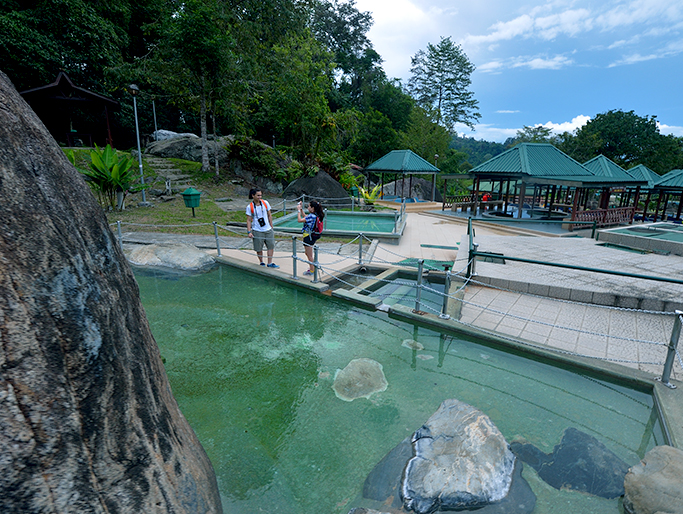
KINABALU PARK
A Premium Wildlife Experience in Malaysia’s First World Heritage Site
As the habitat of more than 4500 species of flora and fauna, Kinabalu Park is a pristine land of a grandeur wildlife experience for all nature enthusiasts.
Established as Malaysia’s first World Heritage Site by UNESCO, the park offers a chance for visitors to get in touch with a premium experience of interacting with the endemic and unique creatures of Sabah. The park surrounds the well-known Mount Kinabalu and covers nearly 754 square kilometres of the area, providing a never-ending journey for all!
The park consists of many fun activities to be explored by nature lovers and is also the Centre of Plant Diversity for Southeast Asia. The thick rainforest is also the home for the world’s largest pitcher plant, Nepenthes Rajah. Although the biggest attraction in this area will surely be the towering Mount Kinabalu, there are still lots of other nature-loving activities that you can enjoy if you’re not ready to conquer the highest peak in Malaysia.
JUNGLE-TREKKING
8 different trails await jungle-trekking fanatics, with all trails providing a unique portrayal of the green landscape around the park. The frequently used trail is the Silau Silau Trail, spanning for about 3 kilometres, providing ample exit points if you’re not looking to complete the whole trail.
PORING HOT SPRINGS
What’s more relieving than soaking your muscles in hot natural water after a long trekking in the jungle? Kinabalu Park also offers a relaxing experience of Poring Hot Springs, so drip away and relax in the hot natural sauna.
WILDLIFE WATCHING
The Botanical Garden is well-fit for visitors who want to have a relaxing and adventure-less trip. Walk around the beautiful garden and learn about all the rare species that inhabit Kinabalu Park. You are also welcomed to go on a bird-watching experience at the top of Bukit Burung.
CANOPY WALKWAY
For a memorable experience of indulging yourselves in the beautiful grandeur of nature in Kinabalu Park, you are advised to go on the Canopy Walkway. Only a 15-minute hike from the entrance, you will be greeted with a worthwhile scenery of green forestry at the 105-metre walkway.
BUTTERFLY FARM
Sabah’s first butterfly farm which is mainly used for research, education, and preservation of Borneo’s endangered butterfly species will give you a unique experience of appreciating various beautiful species fluttering around you.
ORCHID CONSERVATION CENTRE
If the Botanical Garden is not enough for you, head to the Orchid Conservation Centre, which houses the world’s most expensive orchid (about USD 5,000 per plant). This rare species which takes up to 15 years to bloom is endemic to Kinabalu Park and there are still around 1,200 other species of orchids for you to embrace in the park.
RAFFLESIA GARDEN
Sabah is also the home of the largest flower in the world, the Rafflesia. As the unique flower is hard to be seen in the wild, your best chance to embrace it is actually at the Rafflesia Garden.



